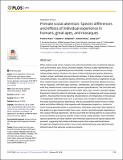Primate social attention : species differences and effects of individual experience in humans, great apes, and macaques
Abstract
When viewing social scenes, humans and nonhuman primates focus on particular features, such as the models’ eyes, mouth, and action targets. Previous studies reported that such viewing patterns vary significantly across individuals in humans, and also across closely-related primate species. However, the nature of these individual and species differences remains unclear, particularly among nonhuman primates. In large samples of human and nonhuman primates, we examined species differences and the effects of experience on patterns of gaze toward social movies. Experiment 1 examined the species differences across rhesus macaques, nonhuman apes (bonobos, chimpanzees, and orangutans), and humans while they viewed movies of various animals’ species-typical behaviors. We found that each species had distinct viewing patterns of the models’ faces, eyes, mouths, and action targets. Experiment 2 tested the effect of individuals’ experience on chimpanzee and human viewing patterns. We presented movies depicting natural behaviors of chimpanzees to three groups of chimpanzees (individuals from a zoo, a sanctuary, and a research institute) differing in their early social and physical experiences. We also presented the same movies to human adults and children differing in their expertise with chimpanzees (experts vs. novices) or movie-viewing generally (adults vs. preschoolers). Individuals varied within each species in their patterns of gaze toward models’ faces, eyes, mouths, and action targets depending on their unique individual experiences. We thus found that the viewing patterns for social stimuli are both individual- and species-specific in these closely-related primates. Such individual/species-specificities are likely related to both individual experience and species-typical temperament, suggesting that primate individuals acquire their unique attentional biases through both ontogeny and evolution. Such unique attentional biases may help them learn efficiently about their particular social environments.
Citation
Kano , F , Shepherd , S V , Hirata , S & Call , J 2018 , ' Primate social attention : species differences and effects of individual experience in humans, great apes, and macaques ' , PLoS One , vol. 13 , no. 2 , e0193283 . https://doi.org/10.1371/journal.pone.0193283
Publication
PLoS One
Status
Peer reviewed
ISSN
1932-6203Type
Journal article
Description
Financial support came from Japan Society for Promotion of Science (JSPS) [grant numbers: KAKENHI 26885040, 16K21108 to FK, KAKENHI 26245069, 16H06301, 16H06283, JSPS-LGP-U04 to SH] and Ministry of Education, Culture, Sports, Science and Technology (MEXT) [K-CONNEX to FK], and the European Research Council [SOMICS 609819 to JC].Collections
Items in the St Andrews Research Repository are protected by copyright, with all rights reserved, unless otherwise indicated.

